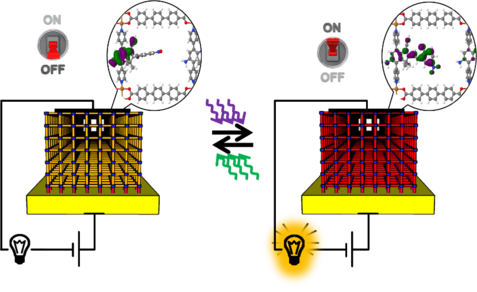Thin MOF films with photoswitchable electronic properties and On-Off conductance
Photo-responsive • electronic conduction • spiropyran
Alina Li,(a) Abhinav Chandresh,(a) Lars Heinke,(a) Dragos Mutruc,(b) Stefan Hecht,(b,c) Mersad Mostaghimi,(d) Mariana Kozlowska,(d) Wolfgang Wenzel(d)
(a) Karlsruhe Institute of Technology (KIT), Institute of Functional Interfaces (IFG), Hermann-von-Helmholtz-Platz 1, 76344 Eggenstein-Leopoldshafen
(b) Department of Chemistry and IRIS Adlershof, Humboldt-Universität zu Berlin, Brook-Taylor-Str. 2, 12489 Berlin
(c) DWI – Leibniz Institute for Interactive Materials, RWTH Aachen University, Forckenbeckstraße 50, 52074 Aachen and Institute of Technical and Macromolecular Chemistry, RWTH Aachen University, Worringerweg 2, 52074 Aachen
(d) Karlsruhe Institute of Technology (KIT), Institute of Nanotechnology (INT), Hermann-von-Helmholtz-Platz 1, 76344 Eggenstein-Leopoldshafen
Thin films of surface-mounted metal-organic frameworks (SURMOFs) with photoswitchable electronic properties and conductance values that can be reversibly changed over several orders of magnitude are the target of this project. Based on our previous proof-of-principle work with spiropyran embedded in MOFs,[1] showing for the first time the remote switching of the electric conduction of a MOF material, we prepare photoswitchable MOF thin films with spiropyran photoswitches incorporated at controlled positions with defined intermolecular distances and orientations. Ab initio calculations of the charge transfer in the MOF and the electronic coupling between the linkers in different MOF structures are performed. It shows that on-off ratios (between the MOF in the non-conductive spiropyran form and in the conductive merocyanine form) of more than three orders of magnitude are possible. The current states of the experimental and theoretical parts of the project will be presented in the talk.
References
(1) Garg, Schwartz, Kozlowska, Kanj, Müller, Wenzel, Ruschewitz, Heinke, Angew.Chem.Int.Ed., 2019, 58, 1193.
Interested in finding out more? Click here to learn more about this overarching COORNETs Phase II team and project.
